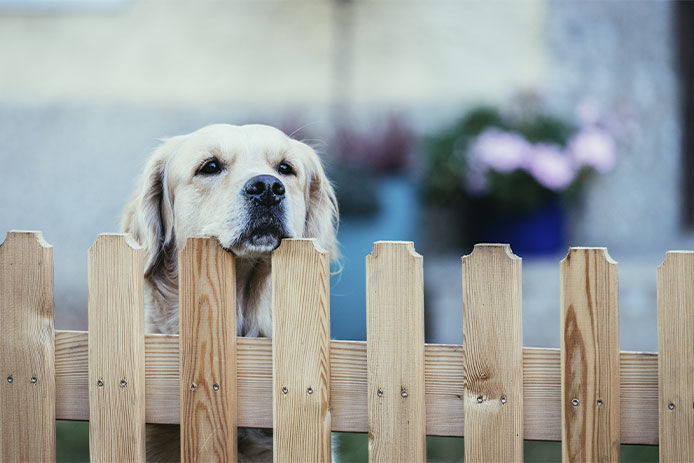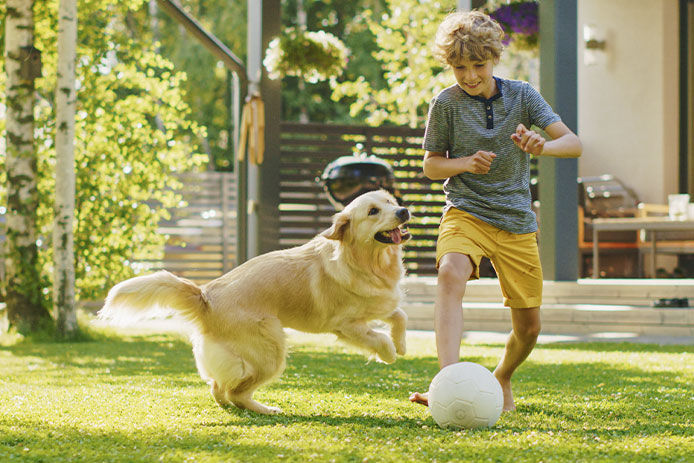How to Make Your Yard Pet-friendly

Just like how we want to make sure everyone in the family has the space to be happy and play, we want the same for our pets. Dogs are our furry family members who offer us unconditional love and loyalty. While dogs need space to roam and explore, some cats also appreciate a little yard area to step outside. As most cats tend to be indoor cats, we're going to focus on how to make your yard pet-friendly for your dogs. However, these guidelines can also apply to our feline friends.
When thinking about making your yard pet-friendly, the main things to consider are safety, comfort, and fun. A good pet-friendly yard will take into account these three elements to ensure that your pets can have a safe place to play and hang out outside.
Put Up a Fence

Fencing is a key feature of a pet-friendly yard. Not only does a good fence keep your pets safely in, but it also keeps other animals out. Depending on where you live, the native animals could pose a threat to your pets in one way or another. Certain predators will happily hunt down small dogs and cats, while larger dogs may run off to chase a porcupine and come home quilled. A proper barrier fence will ensure that pets stay in while other animals stay out. Cats are a little harder to keep in, as they can climb a fence, but they'll be more protected by good barrier fencing. A good fence gives your dog the freedom to run around and play without needing to worry about them escaping or attracting unwanted dogs or animals. There are different kinds of fencing that work well for pets. Depending on where you live, you may want to consider either a barrier fence or an invisible electric fence. There are perks and drawbacks to each, so it's up to you to decide what's best for you and your pet.
Barrier Fencing

A barrier fence works well to keep pets in and undesirables out. However, they can be an eyesore and limit the amount of space your pet has to run free. If you have a barrier fence, be sure to maintain it regularly, check for areas where a dog may be able to squeeze through, and be sure that it's set deep enough that your dog can't dig under to tunnel out. Think like a dog and walk around your fence to be sure your pup will not be escaping any time soon! If you have a barrier fence that you can't see through, include peeking areas for your dog. If dogs can't see across the fence, they can get nervous, bark, dig, pace, or develop other behavioral issues. Peeking areas like spaces between slats or knotholes can help to keep your dog comfortable in the enclosed space.
Invisible Electric Fence

Another kind of fence is the invisible electric fencing. This is perfect for those who have a big yard or live in rural areas and want to keep the dog from straying too far away from the house. The invisible fence will keep the dog within the set area and deliver a tiny electric shock through their collar to startle them if they cross the invisible barrier. The perk of the invisible fence is mainly that it's invisible, but also that it's easier to install and can be switched on and off as you please. The downside is that other animals can still wander into the designated pet area. This style of pet fencing is appealing to those who live in a rural area or with a large backyard that they don't want to fence in.
Install a Water Feature

During hot spells or for water-loving pooches, install a water feature in your yard. A simple plastic or inflatable kiddie pool may be a good source of fun for your dog. Plus, on hot days, it's great for making sure your dog has enough water on hand to cool down and stay hydrated during play. Sprinklers are also a fun way to get your dog wet and cooled off during hot days. Even if you don't have a water feature, keeping a bowl of water in your yard for your pets is important to ensure they stay hydrated. Be sure the water is changed daily to avoid any buildup of grime or harmful bacteria.
Research Plants and Trees

Before letting your pets loose in the backyard, take note of the various trees and plants around. Certain plants and trees can be toxic or poisonous to animals if eaten. Research vegetation native to your area to note any possible plants that would be problematic to your pets. Also, check the plants or flowers you have growing in your garden. Some commonly cultivated flowers, such as lilies, delphiniums, and lupines, can be toxic to pets if eaten. Remove any possibly dangerous native plants and protect cultivated plants from being nibbled with netting or wire fencing.
Provide Shade

Everyone loves a good nap under a tree, and this goes for your pets too. Especially if you live in hotter parts of the country, be sure to have ample shade in your backyard for your pets to relax and cool off under. Trees, bushes, or overhangs make great shade for dogs and cats alike to stay out of the sun on hot and sunny days. A nice shady spot is also a great place to keep a bowl of fresh water to encourage your pets to stay hydrated.
Make it a Fun Place to Play

Make your backyard a fun place for your pets to play. Include toys such as balls, bones, and sticks, as well as a few fun items to mark their territory on, such as tree stumps or rocks. You may even consider giving your pooch a corner of the yard that they can dig in.
With these simple tips, you can easily make your yard pet-friendly so that your furry family members can enjoy playing outside in an area that safe, comfortable, and fun.